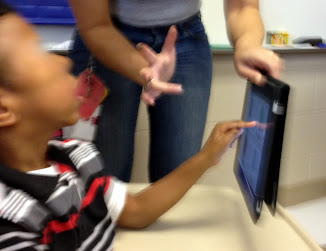Karlie at
We Are ALL Special! recently wrote a
post asking about the roles of paraprofessionals in our classrooms. Originally I was going to just comment on her post but as I started thinking about all the things my wonderful paras do I realized it was too much for one comment! So I decided to sum it up on this week's Think About It Thursday post...
I have two paras (Miss J and Miss T) that have been with me for 6 years (which is my entire classroom teaching career!). Since we all started out together and have been together for so long we have really developed an amazing team (if I do say so myself!). I have a hard time envisioning my classroom without them. We each have different strengths and weaknesses and we have learned over the years how to balance each other out and I plan our schedule and assign roles accordingly.
For instance, I can be a scatter-brain during the day because I am always thinking about the 22 emails I haven't read yet, which IEP is due next week, how to change this students communication device and that students behavior plan, and who hasn't turned in the permission slip for our field trip. Therefore, I have no room in my crazy brain for the "every day" stuff like setting up visual schedules, resetting penny charts, heating up lunches, clearing out the fridge, and stacking chairs. This is where Miss T comes to the rescue! If it wasn't for her I wouldn't remember half of these things until the kids were walking in the door at 8am and then I would really be a scattered mess!!
Miss T is also unbelievably patient. So she is the go-to person for working with kids who can push buttons (who my kids?! NEVER!) or for working with kids that need 10000000 repetitions to master a skill.
Miss T is also the lead para for our "medium" group of kids. So while we rotate reading, writing, and math groups she stays with the medium group and takes care of all of their needs. This includes helping with sensory concerns, redirecting, bathroom breaks, progress monitoring, 1on1 work to differentiate, group material prep, and whatever else might come up!
Miss J is my organizer. She keeps all of our theme files from getting out of control and gets our materials copied and prepped each week (If my brain sounds scattered you should see my desk!). She is also extremely independent so I have her lead a lot of small groups. I provide guidance as far as group goals, daily focus, and overseeing activities but she takes charge of planning her own activities and making modifications as needed. This is wonderful because I think when you plan your own activities you have more ownership so you a) better understand the desired outcome and b) are more likely to be invested in them. For example, I would much rather implement a lesson I personally created than implement a lesson out of a teacher's manual.
Miss J is also the one I rely on to help me figure out all the "bugs" in a plan. Since she leads her own groups, she sees the kids perform some skills more regularly than I do. Therefore, she knows if something isn't working and she will come to me so we can find a solution. Sometimes when I present my aides with an idea, it still needs some work. Miss J will be the one who asks all the questions that make me think "Hmmm I didn't think about that!". This is great because it helps us work out all the variables before trying something new. I would much rather my aides look at me like I am crazy when I come up with a plan than have a group of students looking at me like that! Additionally, Miss J is my confidant. She is the person I know will give me honest feedback about what is going well and what we need to work on. This type of communication is key to creating a great team.
These are just a few of the things my paras do for our classroom. Here is a general list adapted from my
Paraprofessional Handbook
- Supervise students in hallway, lunchroom, and playground situations
- Assist students with daily toileting, self-care, and feeding needs
- Lift/transfer individuals from floor to wheelchair, chair to floor, chair to various other furniture/equipment (after receiving proper training from therapist or teacher)
- Supervise free play activities.
- Attend team planning (we meet for 1 hour weekly after school to discuss student/classroom concerns and plan for the following week)
- With classroom teacher guidance, fill in weekly lesson plan template for groups
- With classroom teacher guidance, lead daily groups
- Gather needed materials for groups
- Record data for groups and transfer to IEP progress monitoring sheets
- Collaborate with classroom teachers and paraprofessionals to plan group activities
- Assist with additional classroom material prep (copies, lamination, cutting)
- Make Boardmaker visuals as requested by classroom teacher
- Assist students with end-of-day jobs
- Sanitize desks and tables, student chairs, and counters in bathroom and kitchen area
- Supervise students during morning work
- Grade papers (non-IEP related)
- Gather needed supplies needed for weekly cooking/art activity (my paras each teach one of these)
- Sharpen pencils
- Assist classroom teacher with reading parent notes in student binders
- Refill reinforcer bins
As I am sure you can tell, my paras are busy, busy, busy in our room! How do you utilize the paras in your classroom? Or how are paras used in your building?





















